About one in two U.S. adults has a musculoskeletal disorder, costing an estimated $213 billion each year in treatment and lost wages, according to a report from the United States Bone and Joint Initiative. Musculoskeletal disorders (MSD) are injuries and conditions to the bones, muscles, and joints that result in pain and can affect activity (e.g., carpal tunnel syndrome, tendonitis). About 140 million Americans live with an MSD. The total of direct and indirect costs for people who have both musculoskeletal disorders and other conditions such as diabetes, heart disease, or obesity is $874 billion, according to the report.
…

Add new comment